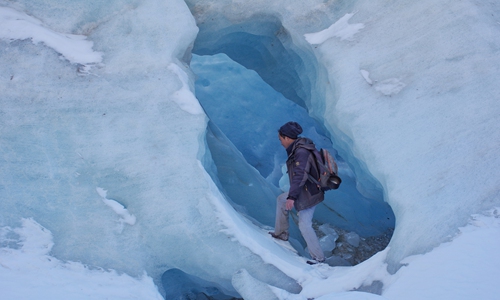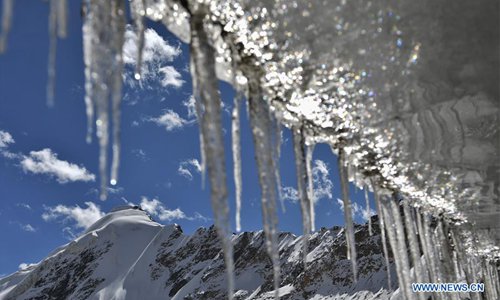
From the People's Daily App.
This is Story in the Story.
From 1970 to 2010, recent data showed that China had lost almost one-fifth of its total glacier coverage. Netizens across the country were astonished and began calling for practical measures to reduce carbon emissions.
China, a country said to have the richest glacier resources in the low and middle latitude, in the 1970s had 48,410 glaciers across more than 60,500 square kilometers, according to the first national glacier study category.
According to researchers, China's glacier coverage fell to 48,000 square kilometers in 2010, a drop of over 20 percent.
Some 8,300 glaciers have disappeared in China and 7,680 square kilometers of glaciers have melted in the country’s Southwest region, a loss of almost 27.7 percent.
Today’s Story in the Story looks at China’s melting glaciers and how awareness is being raised to prevent glacial ablation.

Wang Xiangjun explores a glacier in Bomi county, Southwest China's Tibet Autonomous Region in November 2017. (Photo: Courtesy of Wang Xiangjun)
Wang Xiangjun, a 30-year-old rural Chinese man, displayed videos of glaciers he has been filming for years at the United Nations Climate Change Conference (COP 25) in Madrid in December 2019, calling for attention of the international community on global warming and environmental protection.
His speech was streamed outside the Madrid venue and attracted a large audience, including more than 200,000 viewers on Kuaishou, a popular streaming platform in China.
Wang has been exploring and photographing glaciers since 2012. He started to share short videos to show people the beauty of glaciers in 2017 and has attracted 1.44 million followers on Kuaishou.
He was invited to attend the COP 25 to share his observations about glacial ablation. "I wish more people could notice the beauty of glaciers through my short videos. Glacial ablation and climate change will not be solved unless people know better of glaciers," he said.

Photo taken on Oct. 16, 2019 shows the scenery of the Korchung Kangri glacier in Gyaidar Village in Damxung County of southwest China's Tibet Autonomous Region. (Xinhua)
Wang was born in a rural family in Southwest China's Sichuan Province in 1990 and was addicted to nature since childhood. He has been working outside his village since the age of 20.
Back then, Wang could only find work as a waiter or a cleaner due to his limited education. However, such conditions never impeded his dream of experiencing the natural world.
Wang first saw glaciers in a travel advertisement printed on a bus for Jade Dragon Snow Mountain in Lijiang of Yunnan Province. The magnificent glacier deeply fascinated him. He has visited glaciers every year since he set foot on the glacier in 2012.
Wang is estimated to have trekked more than 70 glaciers over the course of seven years.
"I explored different landscapes every time I climbed the glaciers. Forest on glaciers, blue glacier holes, and ice caves were all vistas of splendor that comforted and inspired me to deeply embrace nature," Wang said.
Wang once found an especially spectacular glacier on a satellite map and decided to go to film the beautiful ice. However, when he went to the scene, he found the vast majority of the glacier had disappeared and melted into a long river. "Since that time, I learned that a lot of glaciers are quickly disappearing. I feel very sad," Wang said.
"That satellite map is normally updated every three years. The glacier melted during that period. Now, the speed of glacial ablation is much faster," he explained.
Whenever glaciers and snowy mountains are mentioned, many Chinese people think of the Alps in Europe, and indeed its photos are more commonly found on the internet.
"Actually, there are many spectacular glaciers in China's Xinjiang Uygur Autonomous Region and Tibet Autonomous Region. I would like to show people the unknown magnificent natural scenery of our motherland," Wang said.
A solo adventure is bound to be dangerous. A bear disturbed his sleep on the evening of January 1, 2018, around Laigu Glacier in Tibet and it tried to enter his room by damaging the house. "I suddenly sat up and tapped the metal utensil while shouting to frighten the bear. Luckily, the bear was scared away," Wang recalled.
"Maybe because of global warming, I felt some bears don't go into hibernation in winter," Wang said adding that "no danger and difficulty can stop me from exploring glaciers."
When he was invited to attend the UN conference, Wang was surprised and questioned how could he, as someone without a college education, be able to give a presentation at the international event.
"However, I was not nervous as I just showed my photos and shared my observation of glaciers. Nature gives me the best education," Wang said.
(Produced by Nancy Yan Xu, Lance Crayon and Brian Lowe. Music by: bensound.com. Text from Global Times.)


